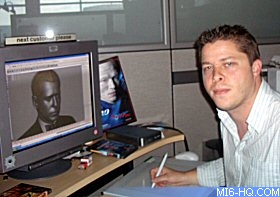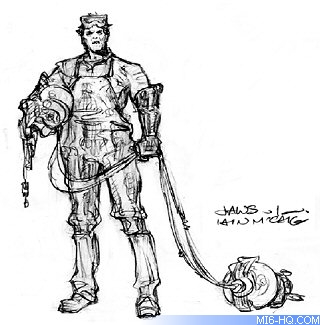 |
| |
MI6 chatted to Darren Pattenden, Lead Character
Artist on "Everything or Nothing", about
designing James Bond... |
|
Darren Pattenden Interview (1)
19th July 2004
How did you land the job at EA?
I'm from London originally. I�ve been drawing ever since I
can remember. I studied illustration at Falmouth School of Art
in Cornwall, England. I returned to London and established myself
as a freelance illustrator for a number of years. Meanwhile, I
got into computer graphics and started editing character skins
for �Quake�. I taught myself 3D modelling and animation with 3D
studio, and soon realized I was hooked and decided I wanted video
games to be more than just a hobby. I applied to EA UK for the
position of character Artist on �Dungeon Keeper 2� and got the
job. That was almost 7 years ago! About 4 and a half years ago
I was offered the opportunity to come across the pond to help
out EA California with �Agent Under Fire� on the modelling side.
I jumped at the chance since I�d always been a Bond fan and I�d
never been to the States before. After AUF shipped I just kind
of forgot to go home afterward!.

Above: Darren Pattenden. |
|
What is it like being a character artist
for a living?
Making digital characters is extremely challenging and
time consuming work. Especially in real time constraints.
But I get a real buzz out of it.
Some mornings I just cant wait to get to work to get cracking
on stuff, and I know that not that many people in this world
are lucky enough to feel that way, so for that I�m grateful!
I recently went back to Britain for a trip, and to see London
buses driving up Oxford street with huge EoN posters on
them was a satisfying and proud moment! |
The characters in Everything or Nothing were convincingly
lifelike, were they created from reference photos alone?
Some were, some were not. The available reference for each
character varied tremendously. For example for Pierce we had some
great orthographic long lens photographs (hence no perspective
distortion), and a digitized head scan. But for Richard Kiel we
had very little to go on. Basically just DVD�s.
When creating female lead�s what was done differently?
With females we tended to put a few more polygons into the
faces and other areas, since women are softer and rounder than
men. Plus we tended to hand paint the texture maps a bit more
to give them a fresher, cleaner look than the males.
Do you prefer creating original characters from concepts &
ideas, or from real life as with the majority of the main EoN
characters?
Well, I get tremendous personal satisfaction from creating
a character and having someone respond with an �oh, that�s X�
straight away. Likenesses have sort of become my speciality at
EA. But at the same time, there�s lots of fun to be had with bringing
a character to life that didn�t previously exist too. So working
with Iain McCaig ( the man responsible for designing Darth Maul
no less ) who was helping us with character concept work was great
fun.
| How did you go about re-creating such
a cult henchman Jaws?
We had little reference for Jaws, so to get his likeness
we used a technique I�ve developed from DVD frame grabs.
If I divulged what that technique was I�d have to kill you
haha! We wanted to bring him into the modern day Bond universe
a little too, so Concept Artist Iain McCaig helped us give
him a bit of an edge.
If you had a chance to improve any of your EoN work,
what would it be and why? What are you most proud of in
your work on EoN?
The thing is that you can iterate on artwork for ever
and ever. There is always room for improvement no matter
how minute. But at some point you have to decide that it�s
within 99.9% of the quality margin that you need it to be
and call it done. So everything you do is within a time
constraint. It sounds like a small thing but engineer friend
and colleague Chris Killpack and myself worked together
and really honed a technique with multi-pass shaders that
we started to play with on Agent Under Fire but took to
new heights on EoN. |
|

Above: A pre-production concept drawing
of the Jaws character from "Everything or Nothing"
by Iain McCaig. |
The day we got the cool metallic glints off of Bonds weapons
as he runs around the level gave the game a sudden subtle leap
in graphical quality. We went on to use it for all sorts of other
areas of the game like subtle specular highlighting on skin. It
was one of those wow moments in video games where all the hard
work seems worthwhile. I�m really proud of how Bond looks too
though. He�s our star after all and I think his �recognizability�
( is that even a word?! ) factor is as high as it�s ever going
to be with a 3D model of that resolution.
What did you enjoy most with your work on EoN? Is there anything
you didn�t particularly enjoy?
To be honest I really enjoyed being the lead and mentoring and
working with my colleagues on the character creation team, Anthony
Mars and Paul David. They deserve credit too for working tremendously
hard on EoN. It was an immense amount of character work for 3
people. Everybody worked hard though. The game on the whole was
a tremendous team effort. We all felt we were part of something
that was really high quality, and that�s a good feeling. Working
on a video game is a labour of love. There were times that I didn�t
enjoy all that pizza.
How difficult is it to get into the games industry nowadays?
Do you think a higher quality is expected at an earlier stage
from artists today compared to 5 years ago?
It all depends on the individual applying and to where. I can�t
really speak for the industry. I know that when we�re looking
for character artists at EA nowadays, we�re looking for the absolute
cream of the crop, since quality level expectations are always
being driven higher. A strong traditional Art background helps
alot. It�s different from 5 years ago. Artists then were more
�Jack of all trades�. All rounders. Modellers, animators, texture
artists, lighters all in one. Nowadays people are much more specialized
like the film industry, so it�s hard to compare to days gone by.
You do have to be very good in your area of expertise though.
Many thanks to
Darren Pattenden.
Related Articles
 "Everything or Nothing"
Coverage
"Everything or Nothing"
Coverage